Selection of photographs and information about original instruments
1. Large end blown from Clogherclemin, Co. Kerry. This horn originally made of three parts fitting together is  incomplete in that the mouthpiece end is missing. It is a good example of the larger instruments from the South West area of Ireland. The age of the instrument is estimated at 800 BC. It is currently on display in The National Museum of Ireland.
incomplete in that the mouthpiece end is missing. It is a good example of the larger instruments from the South West area of Ireland. The age of the instrument is estimated at 800 BC. It is currently on display in The National Museum of Ireland.
2. A pair of horns from Drumbest, Co. Antrim. Two of an original find of four horns. They are in very good  condition. The end blown example is relatively rare in that it survives complete with the mouthpiece. These were the first pair to be reproduced in 1988. They are on display in The Ulster Museum in Belfast.
condition. The end blown example is relatively rare in that it survives complete with the mouthpiece. These were the first pair to be reproduced in 1988. They are on display in The Ulster Museum in Belfast.
3. Side blown horn from Drunkendult, Co. Antrim. This is the smallest of the bronze horn family in Ireland. It is 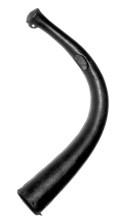 also the most recently recovered instrument, having been found early in the 20th Century. It plays a higher fundamental A tone and a long pedal note series can also be played. The bell end is decorated with six raised cones. It is presently in storage at The National Museum of Ireland.
also the most recently recovered instrument, having been found early in the 20th Century. It plays a higher fundamental A tone and a long pedal note series can also be played. The bell end is decorated with six raised cones. It is presently in storage at The National Museum of Ireland.
4. Side blown horn from Dunmanway, Co. Cork. This is a fine example of the larger lighter horns from the South West of Ireland. It is not in good enough condition to be played so the fundamental is unknown though through 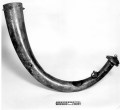 comparison with other complete instruments, it would probably sound an E tone. It is decorated at the bell with six raised cones and there are four holes at the very end. The purpose of these is unknown. Perhaps there were tassels or some form of extension attached. It is presently displayed a The British Museum in London.
comparison with other complete instruments, it would probably sound an E tone. It is decorated at the bell with six raised cones and there are four holes at the very end. The purpose of these is unknown. Perhaps there were tassels or some form of extension attached. It is presently displayed a The British Museum in London.
5. Side blown horn from Derrynane, Co. Kerry. A fine example of a South West side blown horn. This instrument is extremely finely cast. The side walls are so thin that at some point in its playing life the metal broke at the  mouthpiece and a weld repair was made. This is a very early example of such clever metal braising work. Its fundamental note is D and it has a particularly deep haunting tone. The image of the Derrynane horn is used by the Kerry Archaeological Society as their logo. It can be viewed at The National Museum of Ireland in Dublin.
mouthpiece and a weld repair was made. This is a very early example of such clever metal braising work. Its fundamental note is D and it has a particularly deep haunting tone. The image of the Derrynane horn is used by the Kerry Archaeological Society as their logo. It can be viewed at The National Museum of Ireland in Dublin.
6. Original Bronze Age crotals (hand bells) from the Dowris Hoard, Co. Offaly. 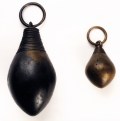
© The National Museum of Ireland.
7. Image of original four wooden tubes, known as the Killyfaddy four circa. 300 BC.
images/icon/original_mayo_simon.jpg" alt="Medieval Loch Erne horn, Co. Fermanagh" width="120" height="220" hspace="20" vspace="10" align="right" />
8. Loughnashade trumpa (only known survivor of four) found in the ‘lake of treasures’ in Emhain Macha, Co.  Armagh. It dates from the first century BC.
Armagh. It dates from the first century BC.
© The National Museum of Ireland.
9. Photograph of John Creed measuring the original Ard Brinn trumpa.

10. Original Bekan horn found near Knock in Co.
Mayo in 1791.
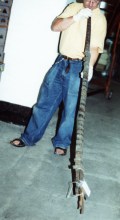
11. Original Early Medieval Loch Erne horn, Co.
Fermanagh. © Ulster Museum.
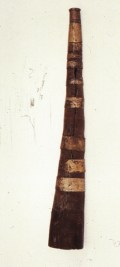
Prehistoric Music
Ireland,
Crimlin, Corrnamona,
Co. Galway, Ireland
Phone: +353(0) 949 548 396
bronzeagehorns@eircom.net
©2005,PREHISTORIC MUSIC IRELAND
 incomplete in that the mouthpiece end is missing. It is a good example of the larger instruments from the South West area of Ireland. The age of the instrument is estimated at 800 BC. It is currently on display in The National Museum of Ireland.
incomplete in that the mouthpiece end is missing. It is a good example of the larger instruments from the South West area of Ireland. The age of the instrument is estimated at 800 BC. It is currently on display in The National Museum of Ireland.